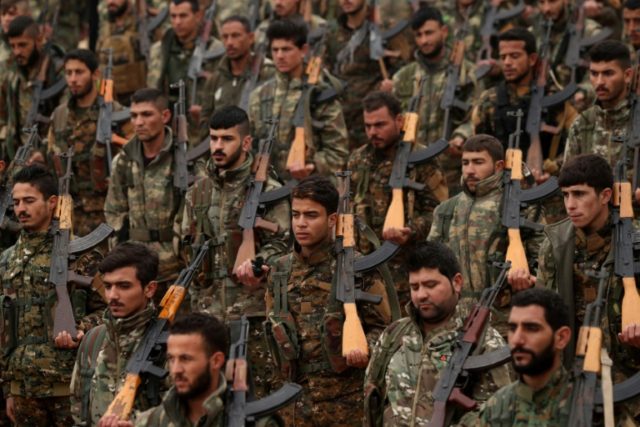The U.S.-led coalition and its Syrian Democratic Forces (SDF) allies have reduced the so-called Islamic State (ISIS/ISIL) caliphate to a small collection of tents in a tiny village under President Donald Trump’s watch, several news outlets acknowledged this week.
“They try a psychological war. But that is it! The war is over, and we won,” a commander of the U.S.-backed Kurdish fighters declared, asking the Associated Press (AP) that he be identified only by his nom de guerre, Baran, in accordance with SDF rules.
The commander acknowledged that the group is holding a small village and indicated that the U.S.-backed force would wait for the jihadis to run out of resources: “They don’t have supplies in the area they are in that would last for a week or more.”
Fighters from the Kurdish-Arab SDF alliance, backed by the U.S.-led coalition, have squeezed ISIS into the last square mile held by the terrorist group in the northeastern Syrian village of Baghouz near the Iraqi border, atop a network of tunnels and cave where more than 300 mainly foreign jihadis are refusing to surrender and are using civilians as human shields, Voice of America (VOA) noted.
The SDF, led and made up primarily of fighters from the Kurdish People’s Protection Units (YPG), is unable to call in airstrikes because of the civilians, the commander of the Kurdish-Arab alliance told AP, adding that ISIS is “moving civilians around at gunpoint as protection.”
According to the Washington Post, there is a “desperate struggle for survival” inside the last speck of land held by ISIS.
“Basic supplies in Islamic State territory have dried up. Prices have soared and civilians have subsisted on what food they have left, adding weeds as bulk to other ingredients when available and boiling the weeds by themselves when that was all they had,” the Post noted on Monday.
Several independent and U.S. government assessments acknowledge that fall of ISIS’s territorial caliphate is imminent, but warn that the group remains a menace as a clandestine insurgency capable of waging attacks.
Last week, Gen. Raymond Thomas, the U.S Special Operations Command chief, cautioned against talk of “winning” against ISIS in Syria.
Asked what winning in Syria would look like, he responded, “I’d be hesitant to use the term winning, as opposed to the objective.”
The “objective is to reduce the threat in that area and to be able to maintain persistent capabilities so that an external threat cannot emanate from that in the future,” he also said, adding, “I do not think we’re there yet.”
“We’re on the verge of diminishing the threat and then in the process of determining what the residual capability needs to remain in place in the region to ensure that we are securing that, securing that objective,” Gen. Thomas declared.
The SDF was reportedly hoping to declare the end of ISIS’s self-proclaimed caliphate last week, but the jihadis are refusing to surrender and trying to negotiate an exit, asking to be allowed to leave to Idlib, home to a stronghold held by al-Qaeda-linked terrorists, or neighboring Iraq.
U.S.-backed fighters have rejected both requests, AP noted, citing the U.K.-based Syrian Observatory for Human Rights, a group that uses ground sources to monitor the conflict.
Activists told AP that the warring parties in the village had extended a ceasefire in place for five days as of Sunday.
Since September, the U.S.-led coalition and the SDF have been fighting the ISIS remnants in the group’s last bastion.
In the wake of U.S. President Donald Trump’s announcement that American troops would withdraw from Syria — a process that has already begun — the SDF declared in a statement back in December 2018, “The war against Islamic State has not ended, and Islamic State has not been defeated.”
Over a month later, however, Elham Ahmad, the co-president of SDF’s political wing, told Breitbart News that the U.S.-backed fighters could“kill” all jihadis on the battlefield in a matter of “weeks.”
Ahmad did warn of the menace posed by lingering “sleeper cells” deployed by the group all over the country.
In December, President Trump announced plans to pull out U.S. troops from Syria, stressing that the 5,000 United States forces in neighboring Iraq are expected to remain with the ability to go into Syria if necessary.
U.S. National Security Advisor John Bolton and Sen. Lindsey Graham (R-SC) have indicated that a residual American force may remain in Syria to ensure ISIS’s lasting defeat, protect the Kurds from Turkey, and combat the threat posed by Iran.
American military and intelligence officials have contradicted President Trump’s assertion that ISIS had been “defeated,” something the commander-in-chief said when he announced the U.S. military withdrawal from Syria.
“ISIS still commands thousands of fighters in Iraq and Syria, and it maintains eight branches, more than a dozen networks, and thousands of dispersed supporters around the world, despite significant leadership and territorial losses,” the World Threat Assessment unveiled by the U.S. intelligence community noted earlier this month.
“According to the DoD, while U.S.-backed Syrian forces have continued the fight to retake the remaining ISIS strongholds in Syria, ISIS remains a potent force of battle-hardened and well-disciplined fighters that ‘could likely resurge in Syria’ absent continued counterterrorism pressure,” the Pentagon inspector general added.

COMMENTS
Please let us know if you're having issues with commenting.